Kevin Clarke
Operetta Research Center
11 October, 2020
From 14 October onwards the Fundación Juan March is presenting a special program dedicated to Jacques Offenbach. The series of events reflects the enormous impact of Offenbach on Spanish popular musical theater and Spanish musical life. We spoke with operetta researcher Enrique Mejías García about Offenbach, compositor de zarzuelas which is also the title of his own upcoming book.

Enrique Mejías García
from the Centro de Documentación y Archivo (CEDOA) de la SGAE. (Photo: Private)
Jacques Offenbach and Spain: is that a new topic, beyond José Carreras and Teresa Berganza singing La Périchole?
Of course not! Actually Offenbach was always present in Spain since 1855 when the composer Barbieri premiered his ‘musical translation’ (as a zarzuela) of Les Deux Aveugles and preserved a musical number from Offenbach’s original score. From 1856 several French travelling companies represented Offenbach’s titles in Madrid and Barcelona but the real craziness was unleashed in 1864 with the release at the Teatro de la Zarzuela of the first Spanish translation: Los dioses del Olimpo (Orphée aux Enfers). Since then, sixty-eight ‘zarzuelas’ were created with music by Offenbach, including several pasticcios and some titles with more than one version. In total, forty-two of his operettas were adapted into Spanish and represented on an equal footing alongside the most exhilarating titles of Fernandez Caballero, Chapí… Lecocq or Suppé.
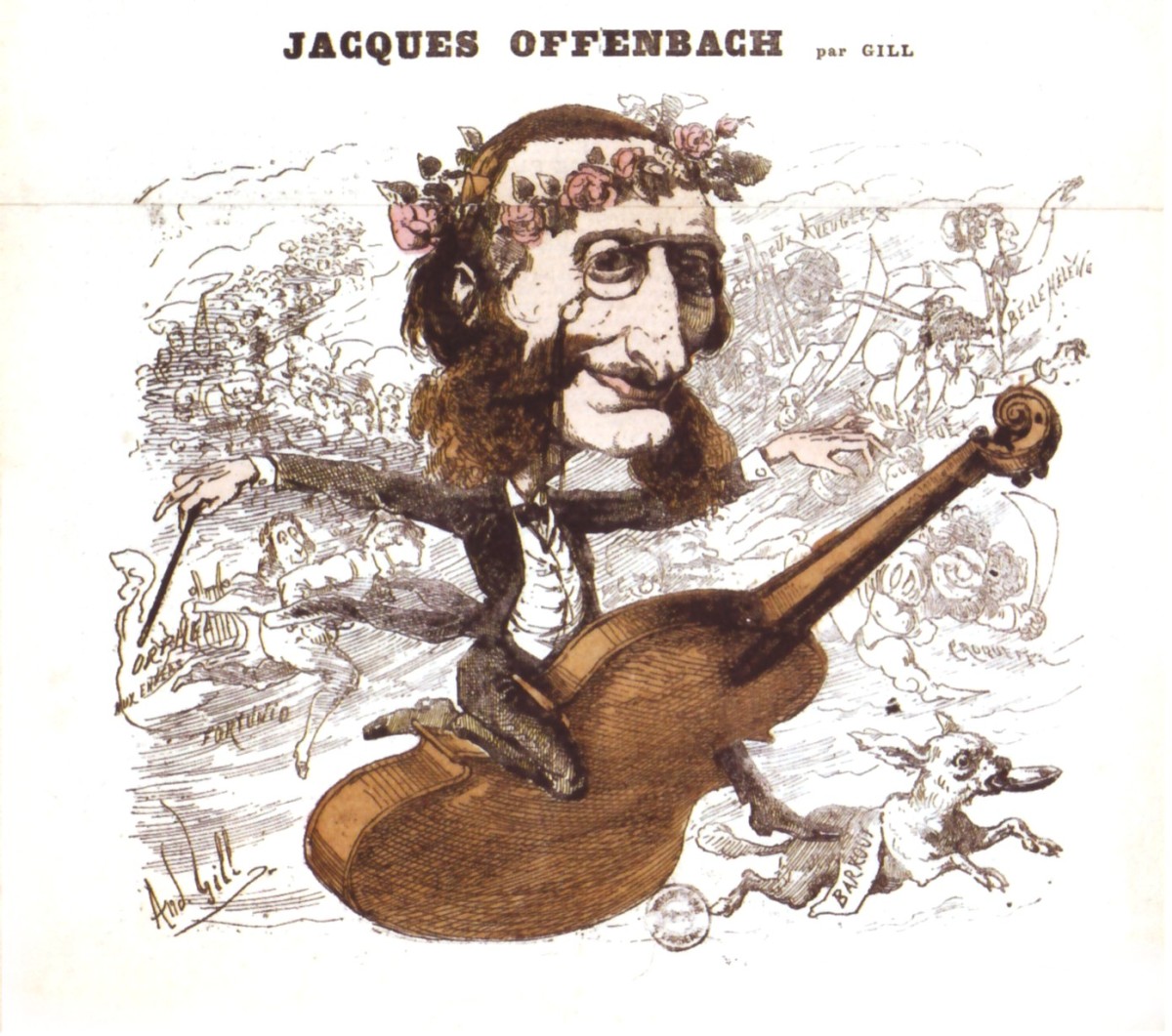
Jacques Offenbach riding his success, a caricature from a Paris newspaper.
You are planning an event series on Offenbach in Spain next week. What is happening, and where and with whom? Can you outline the program and describe who and how it was put together?
When I finished my PhD on these transnational relations between the productive and creative environment of zarzuela and operetta I was contacted by one of the most important cultural institutions in Spain, the Fundación Juan March, interested in turning my theoretical research into a concert series. This is how this cycle of concerts was born: the first one of duos, romances and couplets with historical Spanish translations, the second one, a dramatized reading of El caballero feudal (Croquefer), and the third one of dances and fantasies for piano of Offenbach’s operettas.
The concerts can be followed live on the Fundación’s YouTube channel and on RNE’s Radio Clásica.
You yourself are writing a book on Offenbach from a Spanish perspective. What drew you, as a young progressive person, to Offenbach and operetta, which many people consider pure nostalgia and fluff?
When I was a teenager at the conservatory I only heard about Bach, and my record collection revolved obsessively around Saint Maria Callas. Thanks to a teacher I discovered that there was life beyond so much tragedy, and I entered the fascinating world of zarzuela, which in Spain has the same associated prejudices of nostalgia and fluff. With its particular physiognomy, in zarzuela I found a wonderful world of musical theater (from authentic comic operas to musical comedies and operettas). The recording of Minkowski’s Orphée aux enfers that I bought when I was 16 was to blame for everything else…
What do you friends say about your operetta passion?
I’m lucky to have friends who are even geekier than me and with much more… sordid tastes. Especially the musicologists! Seriously: when I have taken friends who are completely outside this world to see zarzuela/operetta with good productions and interesting artistic proposals they have always been fascinated and have returned to the theater. At least in Madrid and for several years the Teatro de la Zarzuela is much more than old ladies and queens.
When people discuss Spain and operetta, it’s mostly Zarzuela. But that not true, is it? There was Offenbach, Abraham…
Zarzuela is an umbrella label that refer to popular music theatre in Spain between about 1850 and 1950. This multi-genre includes lyric comedy, farce, operetta, revue, musical and of course the Spanish translations of European popular musical theatre! During that century, hundreds of operettas were translated into Spanish and represented by zarzuela companies. My colleague Ignacio Jassa wrote 10 years ago about this reality an article whose final table is impressive (click here). Several operettas by Abraham were received in Spain and El baile del Savoy was still performed in the 1960s at the Teatro de la Zarzuela!

Celia Gámezin Paul Abrahams “El baile del Savoy”, around 1934. (Photo: Ignacio Jassa Haro Collection)
By the way, Jean Gilbert himself came to this theater in 1935, fleeing from the Reich, and here he premiered the lavish operetta Siete colores (Die Dame mit dem Regenbogen). By then the melodies of Die keusche Susanne had been popular in Spain for twenty years.
Who is the greatest Spanish operetta diva?
It is a difficult question to answer but perhaps I would choose Lucrecia Arana, a mythical zarzuela performer at the end of the 19th century who specialized in trouser roles and who also premiered a version of Les Géorgienes (Retolondrón) wich is a title I love.
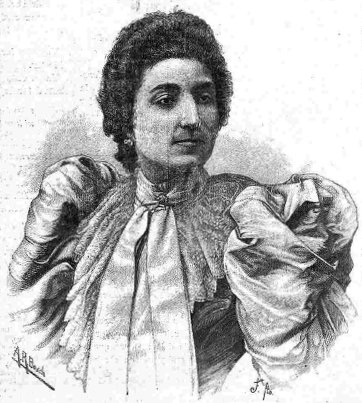
Spanish diva Lucrecia Arana (1871-1927).
But there were other previous ones like Teresa Rivas, who with the company of the Bufos Madrileños (founded in 1866) premiered the main characters of La gran duquesa de Gerolstein, Barba Azul, Genoveva de Brabante y La bella Elena.
Do you have a favorite operetta and/or zarzuela performer?
From that time when artists were not only singers but stars I have a passion for two goddesses of the 20s and 30s called Selica Perez Carpio and Felisa Herrero. Besides premiering such important titles as El caserío, La villana, Luisa Fernanda or La chulapona they recorded many repertoire titles with that way of “telling” that today has been lost with the operatic conventions. In the 90s and 2000 I had the pleasure of seeing many performances of the last authentic diva of zarzuela, the immense Milagros Martín! For example in La chulapona:
You are connected with a Spanish research center: what is that center and what kind of research is done there? Can people outside of Spain access it? How? And what can they find there?
I work in the historical archive of the Society of Authors of Spain (SGAE). Here we preserve the orchestral parts and libretti of the vast majority of the musical theater premiered in Spain between 1850 and 1950: about 10,000 zarzuela/operetta titles!!! We make new editions so that these works can be performed in optimal conditions and the materials are rented by theaters and orchestras. Of course we are open to researchers who want to consult our vast and unique archive (click here).
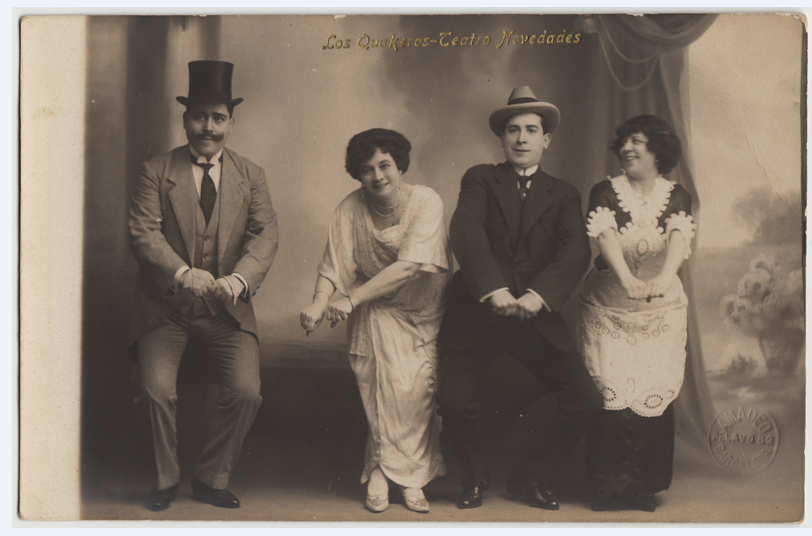
Juanita Manso, Enrique Ramos, Srta. Marín and Sr. Llobregat in “Los Quákeros” by Lionel Monckton, Barcelona, 1914. (Photo: Ignacio Jassa Haro Collection)
In Germany, researchers have devoted much time to operettas from Nazi times and analyzing the genre from a political perspective. Is anything like that going on in Spain, too?
Since the 1990s zarzuela has been very present in musicological studies in Spain. However, I have observed that many scholars have continued to fall into the trap of the “national exceptionality”. Ladies and gentlemen: the musical theater that was performed in Madrid, Barcelona or Havana during the second half of the 19th century was not so different from what was happening in Paris, London or Vienna!
And in the 20th century it is more than evident. It is much more enriching to look at it from a transnational perspective and place Los sobrinos del capitán Grant next to Le Docteur Ox or Las Leandras next to Im weissen Rössl.
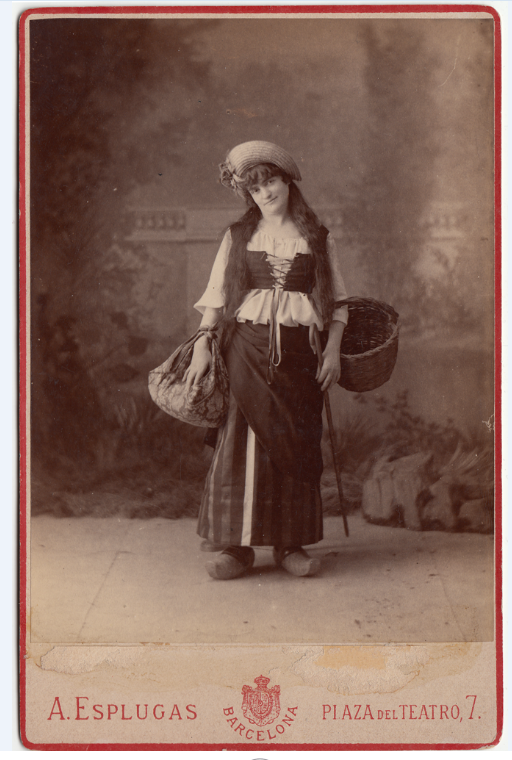
Consuelo Montañés en “La mascota” by Edmond Audran, as seen in Barcelona, around 1882. (Photo: Ignacio Jassa Haro Collection)
If the Spanish research world connected with other research worldwide? Or is it a very isolated operetta world? Has anything changed during the past few years, maybe during Corona?
The truth is that few of us academics are dedicated to researching zarzuela/operetta in Spain. We should be braver, learn more English and go more to international forums. Dialogue would be fundamental and enriching for all. Of course there are exceptions and I refer to the English works of Webber, Lamb or Traubner. In France I must mention the fascinating research of Isabelle Porto and Jeanne Moisand.
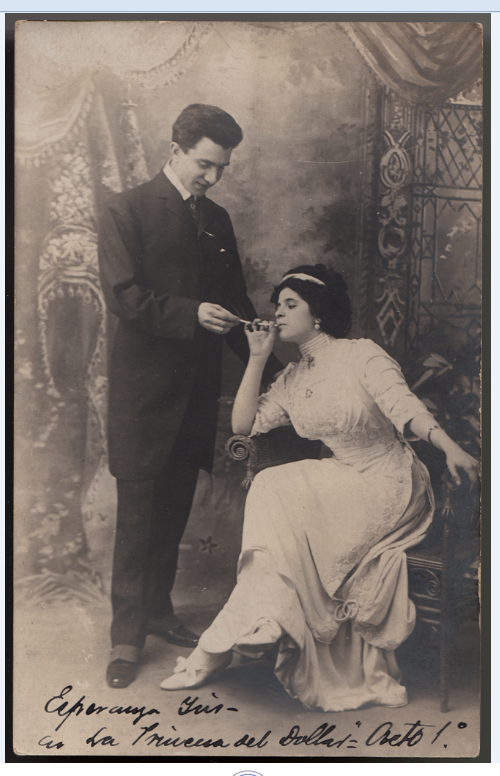
Esperanza Iris and Modesto Cid in a scene from act 1 of “La princesa del dollar” by Leo Fall, possibly in Havana. (Photo: Ignacio Jassa Haro Collection)
When is you book out? And where will the big book release party be?
In just a few months! It will have the same title as this provocative concert series: Offenbach, compositor de zarzuelas (Offenbach, zarzuela composer) edited by ICCMU (Complutense Institute of Musical Sciences). If the coronavirus allows it, will be presented in Madrid in an important place yet to be confirmed… And the party will continue (I hope) for years to come with the scenic recovery of this broad, inclusive and cosmopolitan concept of “zarzuela”!
Enrique Mejías earned a PhD (with honors) in Musicology from the Complutense University of Madrid where he achieved the highest academic recognition from the Ministry of Education through its National Excellency Award and the Complutenses’ Extraordinary Licenciado Award. He currently works as documentalist and musical editor at the Centre for Documentation and Archive of the Spanish Society of Authors and Publishers (SGAE). His research has been published in Revista de Musicología, Cuadernos de Música Iberoamericana, Quodlibet and AEDOM’s Boletín DM among other publications, usually on topics concerning zarzuela and Spanish music of the nineteenth century. He contributes consistently to the Zarzuela.net portal as music critic. In recent seasons he has accepted regular invitations from Teatro de la Zarzuela de Madrid as conference speaker and exhibition curator. He is Coordinator for the musical editions published by Fundación Jacinto e Inocencio Guerrero, and is a member of the advisory board for Cuenca’s Jornadas de Zarzuela.
All images have been kindly provided by Ignacio Jassa Haro from his iconographic operetta collection.

I love Zarzuela music – based on the recordings of individual Zarzuela arias and duets I have heard. But I am struck by the fact that there does not seem to be a single Zarzuela (or indeed a single Spanish opera) that has any profile outside the Spanish speaking world. Does anyone know if there is a quick explanation for this apparent incongruity?